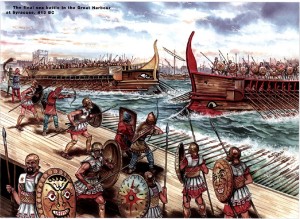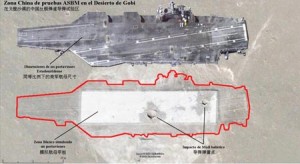For the Athenians, the Great Harbor of Syracuse was anything but. A monument to the Athenian tactic of bottle-necking of the “world’s” most powerful navy, the battle at the Great Harbor symbolizes the cost of trading mobility for convenience. Today, the five carriers lined up in Norfolk like dominoes are reminiscent of that inflexibility, serving as a greater metaphor for constraints the fiscal crisis may impose on the U.S. Navy worldwide.

– General Patton, sort of
During the siege of Syracuse, the Athenian expedition anchored its naval task force inside the protected Great Harbor of Syracuse. Maintaining such a large force in a single place and at anchor decreased the costs of manning and command and control (C2). The single entrance of the harbor and its copious defenses against wind and wave also simplified the fleet’s maintenance and logistics. The convenience came at heavy cost. The fleet’s great numerical advantage was lessened by lack of mobility. Infrequent patrols allowed the Athenians to deploy navigational hazards and blockade runners. Syracuse’s superficially low-cost, reactive approach lost to the proactivity of the enemy. The harbor’s single entrance turned into a nightmare scenario as the massive fleet was locked into the harbor by a chain of ships strung across the entrance. The fleet of the mightiest naval power in the world died in a Sicilian quarry without a single ship remaining.

America’s Great Harbor is not in a foreign land, but up Thimble Shoals Channel and through the gap in the Hampton Roads beltway. Five carriers, the world’s most powerful collection of conventional naval power in one location, sit idle at harbor, one beside the other. The United States maintains a massive naval center of gravity, within a single chokepoint that could be plugged at a moment’s notice in prelude to further enemy action. The concentration not only lends itself to easy containment, but simplifies the potential for espionage and terrorism. The fiscal noose tightening around the Navy’s neck is creating a prime target that goes against every lesson we’ve learned from Pearl Harbor to Yemen.
America’s Great Harbor is a vicarious manifestation of a more terrifying fleet-wide atrophy. Sequestration will force the navy into a fiscal Great Harbor. A 55% decrease in Middle Eastern operational flights, a 100% cut in South American deployments, a 100% cut in non-BMD Mediterranean deployments, cutting all exercises, cutting all non-deployed operations unassociated with pre-deployment workups, as well as a slew of major cuts to training – these further compound the losses from the Navy’s previous evisceration of the training regime. Despite a growing trend of worries about fleet maintenance, a half year of aircraft maintenance and 23 ship availabilities will be cancelled. The snowballing impact on already suffering training and maintenance will further exacerbate that diminishing return on size and quality created by the fiscal Great Harbor. Nations like China and Iran continue to make great strides in countering a force that will recede in reach, proficiency, and awareness. The mighty U.S. Navy is forced to sit at anchor while the forces arrayed against her build a wall across the harbor mouth.

Military leadership has done a poor to terrible job advocating the true cost of defense cuts. A series of actions by the brass has undermined their credibility and covered up the problem. The blinders-on advocation for teetering problems like LCS and the F-35 have undermined the trust that military leadership either needs or can handle money for project development. The Navy personnel cuts were pushed for hard by leadership, and when the Navy grossly overshot its target, the alarms were much quieter than the advocation; the ensuing problems were left unadvertised. In general, military-wide leadership uses public affairs not to inform, but as a method to keep too positive a spin in a misguided attempt to keep the public faith. That public faith has removed vital necessary support in a time when the military is rife with problems that absolutely require funding. The PAO white-wash helps under-achieving programs and leadership get passed over by the critical eye. Where Athenian leaders were frank with their supporters at home, stubbornness and inappropriate positivity have undercut military leadership’s ability break loose from the fiscal harbor.

Those who dismiss the hazard of sequestration are wrong in the extreme. When I was an NROTC midshipman, I remember a map on the wall of the supply building: a 1988 chart of all US Navy bases around the world. Today’s relative paucity of reach leads some to believe that surviving one scaling back shows inoculation against another. However, the law of diminishing returns has a dangerous inverse. Each progressive cut becomes ever more damaging. The U.S. Navy and sequestration apologists must realize what dangerous waters the Navy is being forced to anchor in. The question is, how long can the navy safely stay in the Great Harbor before her enemies get the best of her?
Matt Hipple is a surface warfare officer in the U.S. Navy. The opinions and views expressed in this post are his alone and are presented in his personal capacity. They do not necessarily represent the views of U.S. Department of Defense or the U.S. Navy, although he wishes they did.

Matt…got it, sequestration and the CR are bad, and everyone agrees from virtually every spot on the political spectrum (the only difference being who you blame, which depends on your own political views). I don’t really understand your Syracuse analogy though…tactical failings aside, the Athenian invasion of Sicily was a bad idea because it was a distant foreign adventure that had nothing to do with defeating the Spartans. Sequestration is clearly a self-inflicted shot in the foot, but I’m not clear how it allows the Chinese and Iranians (who last time I checked, we weren’t fighting wars against) to trap us in your rhetorical harbor. Athenian politics was complex and dirty, and domestic political competition did not stop during wartime, just as has often been the case in America’s history. There is no way around that in a democracy (or our system of representative government). The lesson of Athens’ failures in the Peloponnesian War is to avoid imperial overstretch and foreign adventures…I’m not sure how you can tie that to poorly implemented defense spending cuts.
I’m with Mark on this one, other than allowing the use of the picture of carriers at the pier, the Syracuse thing is a complete non-sequitur.
Understood, I was parsing out pieces of the episode for lessons, not the entire Peloponnesian War. Originally, the article was just going to be about the ships in Norfolk, but that led me to think about how we are going to metaphorically get ourselves walled in and not playing to our advantages. The general point being, for cost and convenience, the Athenians washed much of their tactical superiority away and paid dearly for it. I’ve got some other pieces percolating about break-downs of some specifics done in and around the Great Harbor, but all said I see sequestration as a strategic version of that operational/tactical blunder. The carriers in Norfolk will match an existential inflexibility and weakness in our operational forces.
I also think the PAO discussion is particularly apt, since the Athenians almost refused to believe the survivors of the disaster, not imagining from the word they had received from Athens that defeat was even possible. Nicias convinced himself at one point that the end was not near and stalled evacuation of his “no-longer-a-siege” out of misplaced positivity. We really do ourselves a disservice by putting too my foundation on our flaws.
And I’ve got to say, I wish everyone thought sequestration was bad. Yes, military leadership seems to finally be acknowledging it’s possibility, but I have had a myriad of arguments with people both civilian and military who would equate the episode as mere heartburn. There is some polling that shows Americans in favor of massive defense cuts.
http://www.defensenews.com/article/20130130/DEFREG02/301300021/For-Defense-Sector-Americans-8217-Support-Military-Cuts-an-Inconvenient-Truth
Great Harbor is a good start. -a little surprised at no mention of more recent history like Pearl Harbor and what the outcome of WWII might have been had the flat-tops been in port. It’s certainly important to employ Naval weapon systems that offer the greatest economy of force. As I recall, the Chinese gave us very recent lesson (2006) on that subject when they stalked the Kitty Hawk and surfaced their Song-class submarine within weapons range. It’s probably safe to assume the operating cost of that Song class sub is quite modest compared to a U.S. aircraft carrier like the Kitty Hawk. I wonder how many U.S. subs we can keep operating for the cost it takes to keep a carrier operating?
The Pearl Harbor motif has been done quite a bit, I figured I’d try to refresh the debate with an uncommon episode that also illustrates a long view of strategic impact.
As for cost of subs versus A/C carriers, don’t forget that the missions are very different. A sub is great for killing ships, dumping tomahawks onto the beach, inserting SEALs, and certain types of clandestine surveillance… but it is far weaker in alot of other areas, such as C2 and MDA. It’s ability to project from and around the sea is far more nuanced and useful than a sub’s, depending on what you’re doing. It’s a trade-off. However, we do have 7 times as many submarines as carriers for a reason.